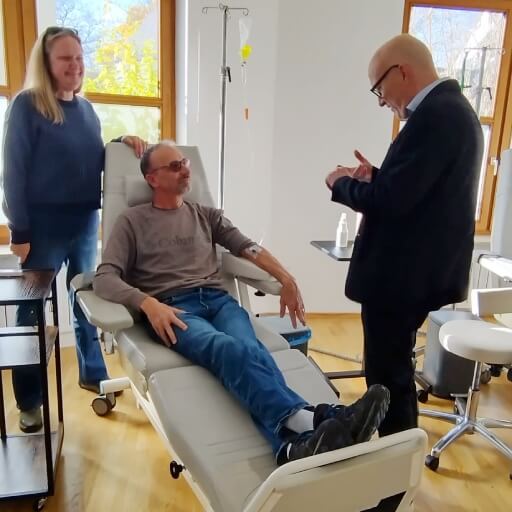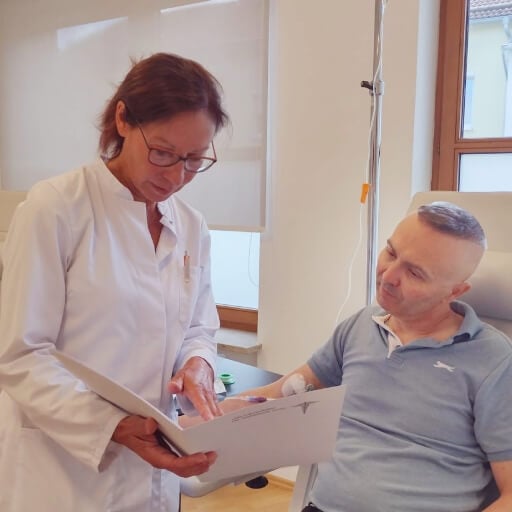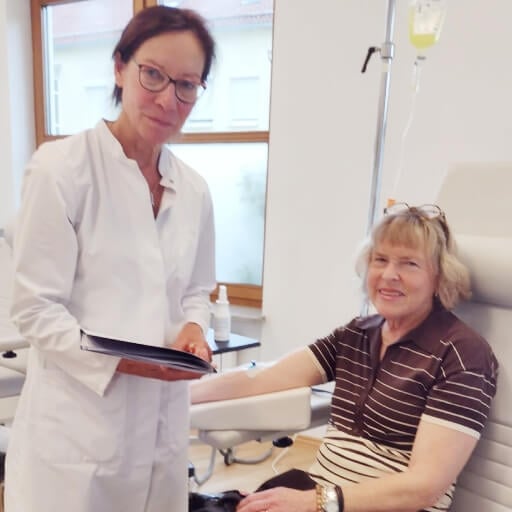Pressurized intraperitoneal aerosol chemotherapy (PIPAC) is a new treatment option for peritoneal carcinomatosis. The technique was developed in 2011 by scientists from the University Hospital of Louisiana, USA. The authors suggested PIPAC as an alternative to HIPEC (hyperthermic intraperitoneal chemotherapy) in patients with peritoneal carcinomatosis. This minimally invasive procedure involves treating the abdominal cavity with a pressurized chemotherapeutic agent, which is spread locally in the form of aerosol.
When a doctor may recommend PIPAC for peritoneal cancer?
Pressurized intraperitoneal aerosol chemotherapy (PIPAC) is a type of regional chemotherapy. During the PIPAC procedure, doctors apply chemotherapy medications in the form of aerosol to kill cancer cells and reduce the size of tumors. PIPAC as a cancer treatment is typically recommended for peritoneal carcinomatosis. This is a condition in which cancer cells from the primary tumor have spread to the peritoneum (tissue lining the abdominal cavity). Since peritoneum covers a large area, its management presents a complicated issue. PIPAC surgery allows for significantly increased local chemotherapy concentrations in the affected areas while minimizing systemic side effects. This chemotherapeutic modality can be used for peritoneal metastases of colorectal, stomach, ovarian, pancreatic, liver, and appendix cancers, as well as mesothelioma and other primary tumors of the peritoneum. PIPAC is mainly the procedure of choice when cytoreductive surgery to remove the neoplasm cannot be performed.
Technical features, advantages, and limitations of PIPAC for peritoneal cancer
Advantages of PIPAC for peritoneal cancer
The PIPAC procedure is an essential part of the comprehensive management of peritoneal metastases as a means of delivering peritoneal cancer medications. As an additional tool to standard therapy, it can significantly improve overall survival, quality of life, and therapeutic tolerance. Studies have shown that using PIPAC for patients with upper gastrointestinal cancer and peritoneal carcinomatosis led to histological regression up to 40%. Researchers state that repetitive PIPAC surgery (specifically, 3 or more procedures) may result in prolonged overall survival rates. There are numerous reports confirming the safe profile and exceptionally well tolerance of the method, making PIPAC a valuable option for patients with peritoneal carcinomatosis.
Technical features
PIPAC is performed in the operating room under general anesthesia. As a laparoscopic surgery, PIPAC implies:
- Making small incisions in the anterior abdominal wall, through which a micropump and a trocar are inserted.
- Administration of a low-dose cytotoxic solution to treat the abdomen (only 10-20% of the standard therapeutic dose). The solution is sprayed with a micropump, which turns the liquid into an aerosol and distributes it evenly over the peritoneum.
- Solution removal. After half an hour, the solution is removed by aspiration through the closed aerosol waste system (CAWS) in the trocar. The procedure is performed with high pressure in the abdominal cavity, which ensures active penetration of the drug into the tissues.
Summarized benefits of the procedure:
- Even distribution of the drug throughout the abdominal cavity
- Deep penetration into the peritoneum
- Low toxicity of the treatment due to the use of low doses of drugs and regional distribution
- PIPAC with platinum works even in platinum-resistant cancer
- The technique is successfully combined with systemic chemotherapy
Side effects are virtually absent as the drug does not enter the systemic bloodstream. Absorption of cytostatics is prevented by the hematoperitoneal barrier.
Limitations of PIPAC for peritoneal cancer
The main relative limitation is a small evidence base. The PIPAC procedure is still being improved. Many studies need to be conducted to determine which types of cancer this method should be used for, at what stages, at what carcinomatosis index, what PIPAC should be combined with, and what chemotherapeutic drugs should be used. Another disadvantage is the impossibility to perform PIPAC in cases of extensive adhesions in the abdominal cavity and massive tumor lesions that prevent adequate access to the abdominal cavity. In patients who have undergone more than one cancer surgery, PIPAC is impossible in one in three patients.

Which is more effective for peritoneal cancer: HIPEC or PIPAC?
Patients often compare PIPAC with surgery and HIPEC. However, it should be understood that each method has its own advantages and disadvantages.
HIPEC for peritoneal cancer
HIPEC for peritoneal carcinomatosis, a stage 4 cancer, has been used for decades. Therefore, the technique is much better investigated. Doctors know exactly how, to whom, and when it is best to administer this procedure. The PIPAC is a relatively new chemotherapeutic intervention, with a smaller evidence base compared to HIPEC. But this minimally invasive technique is safer compared to HIPEC, with much better tolerance and no lengthy rehabilitation. It does not require a wide incision through the entire anterior abdominal wall.
PIPAC for peritoneal cancer
PIPAC can be performed as a stand-alone procedure, even in inoperable patients, including those with affected small intestine and terminal peritoneal carcinomatosis. On the contrary, HIPEC is used only after cytoreductive surgery. Another benefit of PIPAC therapy is that it can be repeated multiple times. In contrast, HIPEC is performed only once. After several PIPAC procedures for inoperable peritoneal carcinomatosis, cancer may regress and become operable. This is not possible with HIPEC because treatment can only begin with surgery to remove the tumors, and if the patient is considered inoperable, he does not receive hyperthermic intraperitoneal chemotherapy.
Current research
Several clinical trials comparing the efficacy and safety of the new PIPAC therapy and classic HIPEC have already been conducted. In a large-scale clinical trial by Girshally et al. involving more than 400 patients, surprising results were demonstrated: after several PIPAC cancer treatments, survival rates were as good as after cytoreductive surgery followed by HIPEC. This is despite the fact that patients in the PIPAC group initially had a worse prognosis because they had inoperable cancer. On average, it took four treatment sessions and six months for patients with advanced peritoneal carcinomatosis to convert to focal carcinomatosis.
Impact on quality of life in peritoneal cancer
PIPAC has advantages over cytoreductive surgery and HIPEC in terms of quality of life. A systematic review and meta-analysis in 2022 (Li, Zhenyue et.al.) showed that PIPAC treated patients with ovarian and gastric cancer suffer less from carcinomatosis symptoms. The procedure itself is better tolerated and the incidence of abdominal pain and bowel obstruction is reduced. A trial by Oyais, A. et.al conducted in Germany demonstrated the high efficacy of PIPAC chemotherapy as a palliative procedure because:
- In 63.3% of cases, it relieved the pain syndrome
- In 60% of cases, it reduced the manifestations of ascites (fluid accumulation in the abdominal cavity)
- It eliminated gastrointestinal discomfort in 45.5% of cases
In addition, 64.5% of patients had a decrease in the peritoneal carcinomatosis index of 4 points or more after two procedures. Based on the high PIPAC success rate, the authors concluded that in inoperable patients it is reasonable to use the procedure as a neoadjuvant treatment, when preparing for cytoreductive surgery.
Thus, some studies show that in the PIPAC vs HIPEC debate, the new technique is at least as effective. At the same time, it is less traumatic, better tolerated, and can be performed without prior cytoreductive surgery.
HIPEC vs PIPAC treatment for peritoneal cancer
| Features | HIPEC | PIPAC |
|---|---|---|
| Type of the procedure | Intraoperatively after cytoreductive surgery (CRS) | Minimally invasive via laparoscopy |
| Indications | Best suited for patients eligible for complete cytoreductive surgery | Suitable for patients with advanced or inoperable peritoneal carcinomatosis |
| Efficacy | Can improve overall survival and sometimes lead to long-lasting remission when combined with CRS in selected patients. Best outcomes in colorectal, ovarian, and mesothelioma cases. | Provides considerable palliative benefit, improves quality of life, and may slow disease progression. Slightly prolongs overall survival. |
| Side effects | Postoperative complications (ileus, infection, renal dysfunction, and hematologic toxicity) | Generally well tolerated: mild abdominal pain and nausea |
| Repeatability | Commonly a single procedure | Can be repeated multiple times |
| Hospital stay | Prolonged (due to surgery) | Short hospital stay / outpatient procedure |
| Price (EUR) | €55,000 - €75,000 | €18,000 - 20,000 |
What to choose: PIPAC or HIPEC for peritoneal cancer?
In most cases, a patient who suffers from peritoneal carcinomatosis caused by colorectal or other type of cancer does not have to choose between HIPEC or PIPAC. The two procedures are not interchangeable as they have different indications. In standard cases, cytoreductive surgery and HIPEC, an intraoperative lavage of the abdomen with a heated solution of chemopreventive agents, are considered the first line of treatment for peritoneal carcinomatosis.
At the same time, PIPAC is used if:
- Surgery is contraindicated due to poor general condition, high carcinomatosis index, small intestine lesions, or any other reasons
- The patient refuses surgical intervention
- Peritoneal carcinomatosis has recurred after previous cytoreductive surgery
PIPAC and HIPEC for peritoneal carcinomatosis are not mutually exclusive procedures either. If a person has undergone several courses of PIPAC and the carcinomatosis index has decreased to the degree where the physician feels it is possible to perform surgery, then cytoreductive surgery with HIPEC may be performed. The order can also be reversed: first the person undergoes surgery and HIPEC, and then he can use PIPAC if the cancer starts to progress again in the distant period after surgery.
However, PIPAC is more often used as a stand-alone procedure rather than as a preparation for surgery. It is commonly recommended for inoperable patients. HIPEC is often performed for colorectal cancer with peritoneal carcinomatosis and ovarian cancer, while most patients with gastric, liver and pancreatic carcinomatosis are not candidates for surgery. For these patients, PIPAC remains a good treatment option. This technique is minimally invasive as opposed to HIPEC and can help to keep the disease under control for a longer period of time, reduce symptoms, and lower the risk of complications.
Patient Success Stories with Booking Health
Where to get treatment for peritoneal carcinomatosis with PIPAC?
If you want to get treatment for intestinal carcinomatosis or other oncologic diseases using PIPAC, consider undergoing therapy in Germany. Being at the forefront of medical advancements, medical hospitals in Germany offer innovative therapeutic approaches for cancer patients. In order to make a thoughtful decision and select the best hospital for your specific case, please contact the specialists at BookingHealth. Our company has solid experience organizing treatment in top medical hospitals around the world. The BookingHealth service provides a list of various hospitals around the world according to your treatment goal. Here you can book a consultation with the company's specialists, find the current prices and choose the clinic in Germany for PIPAC treatment.
Leave your request at the Booking Health website to get a consultation with a medical tourism specialist. The best PIPAC center in Germany specializing in cancer treatment will be selected for you. The cost of medical services when making an appointment through our service will be lower due to the absence of additional charges for foreign patients. All organizational issues regarding the trip are fully covered by our travel management team. Contact BookingHealth to find out more about how to undergo PIPAC treatment in Germany.
Frequently asked questions of our patients about PIPAC for peritoneal cancer
Send request for treatmentPIPAC is a minimally invasive procedure that delivers chemotherapy as an aerosol directly into the abdominal cavity to treat peritoneal carcinomatosis.
PIPAC is performed during laparoscopy – chemotherapy is sprayed as a pressurized aerosol, which improves local drug distribution and penetration while reducing systemic side effects.
PIPAC is used for peritoneal metastases from ovarian, gastric, colorectal, pancreatic, and primary peritoneal cancers, often in cases resistant to systemic chemotherapy.
PIPAC delivers aerosolized chemotherapy at lower doses through multiple sessions, while HIPEC (Hyperthermic Intraperitoneal Chemotherapy) uses heated liquid chemotherapy in a single intraoperative session after tumor removal. PIPAC is less invasive and can be repeated multiple times.
PIPAC allows for higher local drug concentrations with fewer systemic side effects, improves quality of life and can be repeated multiple times, offering a palliative or complementary option when systemic chemotherapy fails.
In Germany, the cost is approximately €18,000-€20,000. You can find prices in particular clinics on the Booking Health website.
It is a minimally invasive laparoscopic procedure that is used for advanced or inoperable peritoneal carcinomatosis – also when surgery is not an option.
With the procedure, cancer patients experience improved QoL and slower disease progression. Response rates for some cancer types (e.g., gastric, colorectal) reach ~50%-75% with repeat treatments.
Generally, it is well tolerated; common reactions are mild, like nausea. Serious complications are rare; however, patients are carefully monitored after the procedure.
It can be repeated multiple times (unlike some one-off procedures). Repeatability improves outcomes in many cases.
Choose treatment abroad and you will for sure get the best results!
Authors:
This article was edited by medical experts, board-certified doctors Dr. Nadezhda Ivanisova, and Dr. Bohdan Mykhalniuk. For the treatment of the conditions referred to in the article, you must consult a doctor; the information in the article is not intended for self-medication!
Our editorial policy, which details our commitment to accuracy and transparency, is available here. Click this link to review our policies.
Sources:
NIH, National Library of Medicine
EJSO - European Journal of Surgical Oncology
Read:
The world’s latest chemotherapy technologies
Article menu:
- When a doctor may recommend PIPAC for peritoneal cancer?
- Technical features, advantages, and limitations of PIPAC for peritoneal cancer
- Which is more effective for peritoneal cancer: HIPEC or PIPAC?
- HIPEC vs PIPAC treatment for peritoneal cancer
- What to choose: PIPAC or HIPEC for peritoneal cancer?
- Where to get treatment for peritoneal carcinomatosis with PIPAC?
- Frequently asked questions of our patients about PIPAC for peritoneal cancer
Don't know where to start?
Contact Booking Health

















